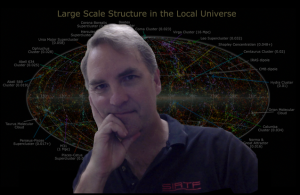Last time I gave the background for our third paper, which is now up on the arXiv here.
So what did we find?
We were looking for so-called Type III Kardashev civilizations, galaxy-spanning civilizations that command power equal to all of the stars in their galaxy. A true Type III civilization would be blocking a significant fraction of all of a galaxy’s starlight from leaving the galaxy, and harnessing it for its own purposes. Such a galaxy would be very faint in optical light — from all of the solar panels collecting the starlight — but very bright in the mid-infrared, where all of that energy would have to come out when the civilization was done using it.
Looking through the WISE catalog, Roger found that zero galaxies were consistent with more than 85% starlight reprocessing by alien industry. This is our first-order upper limit: there are no galaxy-spanning civilizations in galaxies resolved by WISE with aliens using more than 85% of their starlight. This mostly rules out Type III civilizations as Kardashev originally defined them, because they were a sort of maximal case.
We found 50 galaxies (out of 100,000 galaxies surveyed) were consistent with more than 50% starlight reprocessing. Jessica found that most of these have a heavy literature presence, which is not surprising, since they have such extreme MIR emission. They are mostly starbursts; indeed one of the reddest objects we list in our catalog is Arp 220, the quintessential local starburst. We know why they have a lot of MIR emission — the morphology of these galaxies makes it obvious that the emission is from dust illuminated by star formation regions. Once we have gone through all 50 of these galaxies and confirmed the natural origin of their excessive amounts of MIR emission, then our upper limit in Type III civilizations will be around 50%.
We also identified around 90 galaxies consistent with more than 25% reprocessing that have very little literature presence. These are more interesting from a SETI perspective, because it’s possible that they are NOT starbursts (that is, without a lot of study, no one would have noticed anything anomalous about them).
Now, you might be thinking, 85% is a pretty weak upper limit. All those galaxies might be filled with alien civilizations using enormous amounts of power, but just be lost in the glare of all of those stars and dust in the galaxy. But weak upper limits are how all sensitive experiments begin. Raymond Davis (who won the Nobel Prize for detecting cosmic neutrinos) quoted the referee of his first paper on neutrino detection, a very weak upper limit in 1955:
Any experiment such as this, which does not have the requisite sensitivity, really has no bearing on the question of the existence of neutrinos. To illustrate my point, one would not write a scientific paper describing an experiment in which an experimenter stood on a mountain and reached for the moon, and concluded that the moon was more than eight feet from the top of the mountain.
Well, one might if one had no idea how high the Moon was! Indeed, I’m sure our ancient forebears asked as much of the first explorers to return from the highest mountaintops. The idea only seems absurd to us today because we know the answer. In 1955 people thought they knew what sorts of cosmic neutrino fluxes to expect — but one must always be prepared to be surprised!
So, OUR fist upper limit is 85% of a galaxy’s stellar luminosity, and with some work we can get down to 50%. What’s next?
We can still look for Type “2.9” (on Sagan’s scale).

Arp 220, the quintessential local starburst galaxy, as seen by WISE. This galaxy came up very high on our list of galaxies with too much waste heat. As expected, starbursts such as this are our primary confounder. No alien civilization in the local universe uses so much of its starlight’s energy that it has as much 22 micron emission as Arp 220. That’s a new result! Now we know.
We can actually model the SEDs of these galaxies. Star formation and dust emission have many tracers, and there are relationships among luminosities at different wavelengths for the many components that make up a galaxy. By combining optical, NIR, MIR, and radio observations of galaxies, we can ask: which galaxies have MIR excesses given the rest of their SEDs. That will get us even lower.
But we can do much better. Elliptical galaxies have very little MIR luminosity. This means they have a low “natural background” for us to search in. We can get down to a few percent by looking at dust-free elliptical galaxies.
But we can do even better. Because WISE resolves galaxies, we can see if the midinfrared emission traces the stars! The stars in an elliptical should be well mixed, so the civilizations harvesting their energy should be well mixed, and the MIR emission should trace the starlight. MIR emission concentrated in the center is a giveaway that it’s from dust.
Next time: Strange new (non-alien) objects in WISE!





